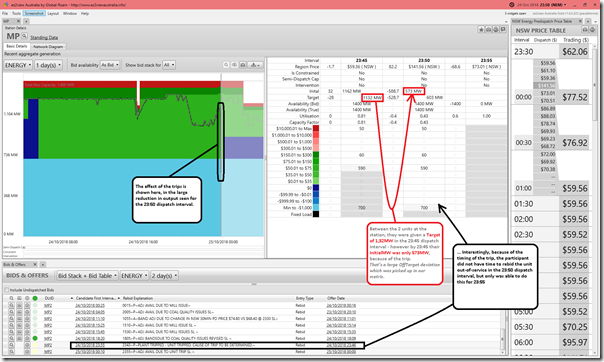As part of the process of compiling our Generator Report Card 2018, we’re taking a look at the instances where individual DUIDs were significantly Off-Target. In our longitudinal summary article today, we can’t see a clear trend emerging to suggest the overall aggregate absolute level of Off-Target is getting substantially worse, or better.
—–
One of the reasons why a generator might be Off-Target it that it might have tripped. Readers should remind themselves that (as noted by our guest author Hugh Saddler) power station trips are normal – but system-wide blackouts are not. Sometimes the trips appear to be intentionally triggered, which is something we’ll be looking further into.
Using “Time-Travel” in our ez2view market analysis software, we’ve wound back a particular dashboard in ez2view back to the 23:50 dispatch interval on 24th October 2018, in order to show what happened within the 23:45 dispatch interval:
In this particular case, we see that AEMO was expecting the contribution from the 2 units at Mt Piper to be 1132MW by the end of the 23:45 dispatch interval – but instead (because of the trip of Unit 2) the total contribution was only 573MW. That’s a shortfall of 559MW.
In a separate article, guest author Allan O’Neil has previously described in some detail what happens when contingency events (like unit trips) occur – particularly in terms of the contributions from numerous units, some FCAS enabled, to keeping system frequency close to 50Hz.
What’s of particular interest to us in our Generator Report Card 2018 is whether the incidence of trips has changed significantly from that which has happened in the past. Is it getting worse (as those promoting the #coalfail meme are proposing), and what are the differences from station to station.



Leave a comment